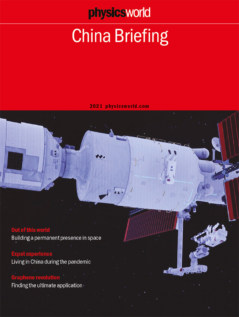While many activities here on Earth have slowed down or been put on hold due to the COVID-19 pandemic, that has not stopped China – and other countries – from forging ahead in space. China has managed several firsts this year, notably landing its first rover on Mars, starting construction of a fully-fledged space station, and successfully returning samples from the Moon.

In this year’s Physics World China Briefing, we report how that progress is only set to accelerate, with China’s space station set to be complete next year, giving it a permanent presence in Earth’s orbit for the next 10 years and more. The mid-2020s will also see China put a dedicated optical space telescope in orbit as well as launch further lunar craft. It may even start building a Moon base by the end of the decade – not to mention an asteroid and further missions to Mars.
We talk to some of the minds behind those missions, including Su Yan from the National Astronomical Observatories of China, Chinese Academy of Sciences, who has played a key role in China’s exploration of the Moon.
Back on Earth, China is also making a big push in materials science, which is set to play a large role in progress towards seven major research areas – including aerospace technology and quantum technology – that China has highlighted in its 14th five-year plan that began this year.
In this year’s briefing, we talk to Zhongfan Liu, founding president of Beijing Graphene Institute, about how it is pioneering the industrialization of new graphene materials as well as Weihua Wang, director of the Songshan Lake Materials Laboratory in Dongguan about a new joint venture with IOP Publishing, which publishes Physics World.
Let us know what you think about the publication on Twitter, Facebook or by e-mailing us at pwld@ioppublishing.org.
